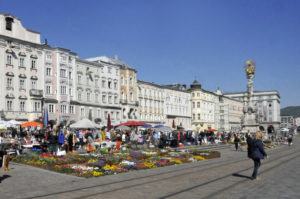
City Square of Linz, Austria (Photo by Don Knebel)
Linz was founded as a trading village by the Romans on both sides of the Danube River, 19 miles south of Austria’s current border with the Czech Republic. By the fifteenth century it had become the most important city in the Holy Roman Empire, attracting people from all over Europe. Johannes Kepler lived in Linz from 1612 to 1626, teaching mathematics. While there, he discovered his third law of planetary motion. On October 1, 1762, Wolfgang Amadeus Mozart, then six, gave his first public performance at a Linz inn. He stopped by Linz in late 1783, where he wrote his 36th Symphony in four days.
Nine-year-old Adolph Hitler moved with his parents to Linz, where he lived until he was 18. On March 13, 1938, Hitler announced to cheering crowds the annexation of Austria from the tiny balcony of Linz’s town hall, gaining Linz the Nazi title of “City of the Founding of the Greater German Reich.” Hitler dreamed of making Linz, which he considered his “home town,” the cultural center of Europe and made grandiose plans for a museum in Linz to display art stolen from the Jews of Europe. The plans were never realized.
Today, Linz, with a population of about 200,000, is a recognized center of electronic media and one of 69 UNESCO “Creative Cities.” An unusually large city square, dating to the 13th century, features a marble statue celebrating the Holy Trinity and hosts outdoor markets year round. Linz guides show visitors the inn where Mozart first performed and the university and buildings honoring Kepler. Confronting their city’s association with Hitler, guides also point to the streets and monuments remembering the victims of Nazi horrors.
Comments are closed.